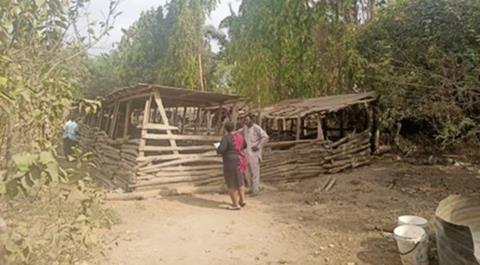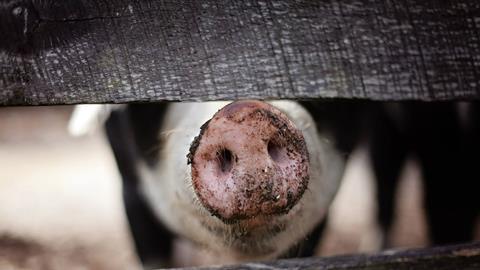Pig farming is one of the most lucrative livestock businesses globally due to the prolific nature of the animal and its relatively short reproductive cycle compared to other food animals.
A well-fed and healthy sow can farrow twice a year, giving birth to at least ten piglets at a time. Also, the pig has a short life cycle; a pig can attain a marketable size of 280 lbs. (120 kg) within six months after birth. Pig farming has the potential to solve problems associated with poverty, hunger, and malnutrition, especially in developing regions of the world. Despite the vast potential of pig farming, the business is faced with many disease problems orchestrated by numerous infectious agents, including the porcine circovirus 2 (PCV2), which can decimate herds and impair productivity.
PCV2 is a single-stranded DNA virus belonging to the family Circoviridae; it is the primary aetiologic agent of porcine multisystemic wasting syndrome (PMWS), which is of enormous economic importance in the swine industry globally. The viral agent is also the causative agent of numerous swine diseases collectively named porcine circovirus-associated diseases (PCVAD), which include porcine dermatitis and nephropathy syndrome, porcine circovirus reproductive disorders, porcine respiratory disease complex, enteritis, acute pulmonary edema, nervous system lesions, proliferative and necrotizing pneumonia, and neonatal congenital tremor. PCV2 infects pigs of all ages and swine herds of all statuses (communal and commercial), and it has been found in all pig-producing countries of the world, leading to significant economic losses. The pathogenesis of the virus consists mainly of immunosuppression of the infected animals through the depletion of lymphoid tissues, thereby making them susceptible to secondary infections. Hence, infection with PCV2 can be aggravated further by co-infection with many other viral, bacterial, and protozoal pathogens, resulting in different clinical outcomes and severely affected herds.

Despite the global importance of PCV2, the virus is understudied in the sub-Saharan African region. In Nigeria, large-scale research on the virus to determine its prevalence is lacking; also, there is a paucity of information about risk factors that facilitate its occurrence, spread, and transmission. Therefore, we conducted a molecular-based cross-sectional study and mapping of PCV2 in swine herds in southwestern Nigeria to determine its prevalence, spatiality, associated risk factors, and molecular characterization of its circulating genotypes in swine herds of the region. The study aimed to give policymakers and other stakeholders in the pig industry in Nigeria the necessary information to mitigate its ravaging effects.
Adventurous trips to the field in search of PCV2
In January-February 2022, our research team toured the cities and remote towns of three selected southwestern states (Ondo, Oyo, and Lagos) of Nigeria for sampling, conducting one-on-one interviews, as part of the preliminary efforts to execute our study on PCV2. Critical observation and documentation of the clinical manifestation/symptoms of PCV2 infections were equally carried out for each farm visited.

The research visits not only focused on collecting samples from visited farms but also provided an opportunity for our formidable team to organize an awareness/sensitization campaign on PCV2 and its associated diseases with the pig farmers. This became imperative as it was observed from our previous preliminary study that most pig farmers in the region are unaware of PCV2, revealing a great need for education about the pathogen and its potential effect on their business and livelihood.

From the field to the laboratory: the search continues
Following the successful completion of fieldwork, rigorous laboratory activities began at the Centre for Human Virology and Genomics Research in Lagos. The 648 individual samples obtained from 67 farms were screened for PCV2 using an established polymerase chain reaction protocol. Geospatial distribution of the virus in the study area was confirmed, and the risk factors contributing to its transmission and distribution were evaluated.
It is highly significant that the occurrence of PCV2 in Nigerian pigs has been re-confirmed. A very high overall farm-level prevalence of 73% was recorded, with 22% animal-level prevalence. Furthermore, the sequencing and genetic characterization of 15 randomly selected PCV2-positive samples showed the circulation of PCV2b (60%) and PCV2d (40%) viral genotypes, which are known for higher-level virulence compared to other genotypes. From our PCV2 risk factor analysis, the restriction of visitors’ entrance to farms was found to be strongly protective for PCV2, while not having a quarantine protocol and reporting coccidiosis as a common disease were also significant risk factors identified as being associated with the presence of the PCV2.
A comprehensive surveillance study to determine the extent of the spread and prevalence of any infectious pathogen is the first step in the right direction to mitigate its ravaging effect, whether in humans or animals.
As our current findings on PCV2 in Nigerian pigs demonstrate, there is an urgent need for the government and its agencies to ensure the availability of vaccines to the farmers in the country as part of its essential measures to mitigate the wide spread of PCV2 and its associated diseases. Furthermore, there is a need for stakeholder engagement, co-development, and co-implementation of the vaccination policy, to ensure an accelerated vaccine acceptance and uptake by pig farmers. The very high farm-level prevalence of PCV2 obtained in our study indicates the wide spread of the virus. Hence, the need to promote large-scale vaccination and strict biosecurity measures for effective mitigation cannot be overemphasized. This will help alleviate economic loss due to the viral pathogen and its numerous associated diseases, thereby ensuring sustainable and profitable swine production in the country.








1 Reader's comment